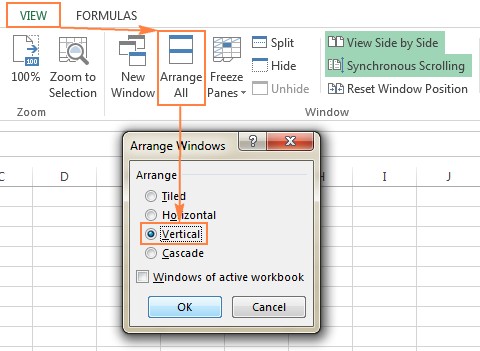Comparing two Excel sheets and finding the difference can be a time-consuming and tedious task. With numerous methods available, COMPARE.EDU.VN provides a comprehensive guide to streamlining this process. Learn how to efficiently identify discrepancies, highlight changes, and merge data, empowering you to make informed decisions. Discover the best methods for comparing Excel sheets and workbooks.
1. Comparing Excel Files Side by Side for Visual Inspection
The “View Side by Side” feature offers a straightforward approach for visually comparing two Excel files. This is perfect for smaller workbooks where you can easily spot differences with your own eyes.
1.1. Comparing Two Excel Workbooks Simultaneously
Imagine you need to compare sales reports from two different months to see which products performed better. The “View Side by Side” feature lets you do just that:
- Open both Excel workbooks.
- Go to the “View” tab, locate the “Window” group, and click the “View Side by Side” button.
This will display the two workbooks horizontally.
For a vertical arrangement:
- Click “Arrange All” on the “View” tab.
- Select “Vertical.”
To scroll through both worksheets simultaneously, ensure “Synchronous Scrolling” is enabled in the “Window” group on the “View” tab.
1.2. Arranging Multiple Excel Windows for Comprehensive Comparison
Need to compare more than two files? Here’s how:
- Open all Excel files.
- Click “View Side by Side.” In the dialog box, select the files to compare with the active workbook.
Alternatively, click “Arrange All” and choose a layout like “tiled,” “horizontal,” “vertical,” or “cascade.”
1.3. Comparing Two Sheets Within the Same Workbook
Sometimes, the sheets you want to compare are in the same workbook:
- Open the Excel file. Go to “View” > “Window” and click “New Window.”
- This opens the same file in a new window.
- Enable “View Side by Side.”
- Select the sheets you want to compare in each window.
2. Utilizing Excel Formulas to Identify Value Discrepancies
This method provides a simple way to identify cells with different values, creating a “difference report” in a new worksheet.
To compare two Excel worksheets:
-
Open a new, empty sheet.
-
Enter the following formula in cell A1:
=IF(Sheet1!A1 <> Sheet2!A1, "Sheet1:"&Sheet1!A1&" vs Sheet2:"&Sheet2!A1, "") -
Drag the fill handle to copy the formula down and to the right.
This formula dynamically compares cells in “Sheet1” and “Sheet2,” displaying differences. However, note that dates may appear as serial numbers in the report, which can be inconvenient.
3. Conditional Formatting for Visually Highlighting Differences
Conditional formatting offers a visual approach to highlight differing cells with a color of your choice.
- In the worksheet where you want to highlight differences, select all used cells by clicking the upper left cell (usually A1) and pressing Ctrl + Shift + End.
- Go to “Home” > “Styles” > “Conditional Formatting” > “New Rule.”
- Create a rule using the formula:
=A1<>Sheet2!A1(replace “Sheet2” with the actual sheet name).
3.1. Limitations of Formulas and Conditional Formatting
While helpful, these methods have limitations:
- They only compare values, not formulas or formatting.
- They cannot identify added or deleted rows/columns correctly.
- They don’t detect workbook-level changes (sheet additions/deletions).
4. Comparing and Merging Shared Workbook Copies
The “Compare and Merge” feature streamlines merging versions of a shared Excel file, especially when multiple users are involved.
4.1. Preparing for Collaboration
- Share the workbook before edits: On the “Review” tab, in the “Changes” group, click “Share Workbook,” check “Allow Changes by More Than One User…,” and click “OK.” Saving the workbook with Track Changes turned on automatically shares the workbook.
- Each user must save their copy with a unique file name (.xls or .xlsx).
4.2. Enabling “Compare and Merge Workbooks”
This feature isn’t visible by default:
- Open the Quick Access Toolbar dropdown and select “More Commands.”
- In “Excel Options,” choose “All Commands.”
- Find “Compare and Merge Workbooks,” select it, and click “Add.”
- Click “OK.”
4.3. Merging the Workbooks
- Open the primary version of the shared workbook.
- Click the “Compare and Merge Workbooks” command in the Quick Access Toolbar.
- Select the copies to merge (hold Shift to select multiple files) and click “OK.”
4.4. Reviewing Changes
- Go to “Review” > “Changes” and click “Track Changes” > “Highlight Changes.”
- In the “Highlight Changes” dialog:
- Select “All” in the “When” box.
- Select “Everyone” in the “Who” box.
- Clear the “Where” box.
- Check “Highlight changes on screen.”
- Click “OK.”
Excel will highlight column letters and row numbers with differences in dark red. Individual edits will be marked with different colors, and hovering over a cell reveals the user who made the change.
4.5. Important Note:
The “Compare and Merge Workbooks” feature only works with copies of the same shared workbook. It cannot merge completely different Excel files.
5. Third-Party Excel Comparison Tools: A Comprehensive Overview
While Excel offers basic comparison features, dedicated third-party tools provide more comprehensive solutions for identifying and merging differences in values, formulas, and formatting.
5.1. Synkronizer Excel Compare: A Versatile 3-in-1 Tool
Synkronizer Excel Compare add-in streamlines the comparison, merging, and updating of Excel files, eliminating the need for manual searches.
Key features include:
- Identifying differences between Excel sheets.
- Combining files without creating unwanted duplicates.
- Highlighting differences.
- Filtering relevant differences.
- Merging and updating sheets.
- Generating detailed, user-friendly reports.
5.1.1. Comparing Excel Files with Synkronizer
Imagine organizing an event and using an Excel table to track participant details (name, arrival date, etc.). With multiple managers updating the database, you end up with two versions of the same file.
Here’s how Synkronizer efficiently compares the sheets:
- Go to the “Add-ins” tab and click the Synchronizer 11 icon.
-
In the Synkronizer pane:
- Select the two workbooks to compare.
* Select the sheets to compare. If workbooks have identically named sheets, they are matched automatically (e.g., "Participants"). You can also select sheets manually or by worksheet type (all, protected, hidden).* Select a comparison option:
* "Compare as normal worksheets" (default)
* "Compare with link options" (for sheets with no new/deleted rows/columns)
* "Compare as database" (recommended for database-structured sheets)
* "Compare selected ranges" (for comparing specific ranges)
* Choose content types to compare (optional): On the "Select" tab, in the "Compare" group, select relevant content types like comments and names (in addition to values, formulas, and calculated values which are compared by default). You can also choose cell formats (alignment, fill, font, border, etc.).
* Apply filters to exclude unwanted differences (e.g., ignore case, leading/trailing spaces, formulas, hidden rows/columns).- Click the “Start” button.
5.1.2. Analyzing Results with Visualized Differences
Synkronizer generates two reports on the “Results” tab:
- A summary report providing a high-level overview of changes in columns, rows, cells, comments, formats, and names.
- A detailed difference report accessible by clicking a specific difference type in the summary report.
Clicking a difference in the detailed report highlights the corresponding cells in both sheets (only one shown in the screenshot below).
A separate difference report workbook (standard or hyperlinked) can also be created, allowing you to jump to differences with a simple click.
5.1.3. Comparing All Sheets at Once
For files with multiple sheets, all matching pairs are presented in the summary report.
5.1.4. Highlighting Differences for Easy Identification
Synkronizer highlights all found differences by default:
- Yellow: Differences in cell values.
- Lilac: Differences in cell formats.
- Green: Inserted rows.
You can highlight only relevant differences by clicking the “Outline” button and selecting the desired options.
5.1.5. Updating and Merging Sheets Seamlessly
The merge function is a key feature. You can transfer individual cells or move entire columns/rows from the source to the target sheet, updating your primary sheet in seconds.
Select the differences and click one of the four update buttons. The first and last buttons update all differences, while the second and third update selected differences only (arrow indicates transfer direction).
5.2. Ablebits Compare Sheets for Excel
Ultimate Suite includes a tool called Compare Sheets.
Key benefits:
- A step-by-step wizard guides you through the comparison process.
- You can select the optimal comparison algorithm for your data.
- Instead of a separate report, the sheets are displayed in “Review Differences” mode for managing differences one-by-one.
5.2.1. Using Ablebits Compare Sheets
-
Click “Compare Sheets” on the “Ablebits Data” tab, in the “Merge” group.
-
Select the two worksheets to compare. The entire sheets are selected by default, but you can select a table
or a specific range
-
Choose the comparison algorithm:
- “No key columns” (default) – best for sheet-based documents like invoices.
- “By key columns” – suitable for column-organized sheets with unique identifiers.
- “Cell-by-cell” – ideal for spreadsheets with the same layout and size (e.g., balance sheets).
-
Select the match type:
- “First match” (default) – compares a row in Sheet 1 to the first row in Sheet 2 with at least one matching cell.
- “Best match” – compares to the row with the maximum number of matching cells.
- “Full match only” – finds rows with identical values in all cells.
-
Specify which differences to highlight/ignore and how to mark them. For example, you can select “Show differences in formatting” and ignore hidden rows/columns.
- Click “Compare.”
5.2.2. Reviewing and Merging with Ease
Once processed, the worksheets open side-by-side in “Review Differences” mode with the first difference selected.
- Blue rows: Exist only in Sheet 1 (left).
- Red rows: Exist only in Sheet 2 (right).
- Green cells: Difference cells in partially matching rows.
Use the vertical toolbar on each worksheet to navigate differences and decide whether to merge or ignore them. The toolbar for the inactive worksheet is disabled.
When all differences are addressed, you’ll be prompted to save or exit “Review Differences” mode. The toolbar also allows saving changes while removing remaining difference marks.
5.3. xlCompare: Comprehensive Workbook and VBA Project Comparison
xlCompare compares Excel files, worksheets, names, and VBA projects. It identifies additions, deletions, and changes, allowing for rapid merging. Additional options include:
- Finding and removing duplicate records.
- Updating existing records with values from another sheet.
- Adding unique rows and columns.
- Merging updated records.
- Sorting data by key columns.
- Filtering comparison results.
- Highlighting results with color.
5.4. Change pro for Excel: Mobile-Ready Excel Sheet Comparison
Change pro for Excel allows sheet comparison in desktop Excel and on mobile devices, with optional server-based comparison.
Key features:
- Identifying differences in formulas and values.
- Detecting layout changes (added/deleted rows/columns).
- Recognizing embedded objects (charts, graphs, images).
- Creating and printing difference reports.
- Filtering, sorting, and searching the reports.
- Comparing files directly from Outlook or document management systems.
- Supporting all languages.
6. Online Services for Quick Excel File Comparisons
For immediate results without installing software, online services offer a convenient option. While security is a consideration, these are helpful for non-sensitive data.
For example, XLComparator and CloudyExcel offer this functionality. Here’s how CloudyExcel works:
Upload two Excel workbooks and click “Find Difference.” The differences in the active sheets are highlighted.
7. Frequently Asked Questions (FAQ) on Comparing Excel Sheets
1. What is the easiest way to compare two Excel sheets?
The easiest way depends on the size and complexity of your sheets. For small sheets, the “View Side by Side” feature might suffice. For more complex comparisons, using Excel formulas or conditional formatting can quickly highlight differences.
2. Can I compare two Excel files without installing any software?
Yes, online services like XLComparator and CloudyExcel allow you to upload and compare Excel files directly in your browser.
3. How do I highlight differences between two sheets automatically?
Excel’s conditional formatting feature allows you to automatically highlight cells with different values based on a formula.
4. Is there a way to compare two Excel sheets and create a difference report?
Yes, you can use Excel formulas to create a new sheet that displays the differences between two other sheets.
5. What is the best tool for comparing complex Excel files with many sheets and formulas?
Third-party tools like Synkronizer Excel Compare and Ablebits Compare Sheets offer advanced features for comparing complex Excel files, including the ability to compare formulas, formatting, and identify added/deleted rows/columns.
6. How can I merge changes from one Excel file into another?
The “Compare and Merge Workbooks” feature is designed for merging changes from copies of a shared workbook. Third-party tools also offer merging capabilities.
7. Can I compare two sheets for differences in formatting?
Excel’s built-in features don’t directly compare formatting. However, third-party tools often include this capability.
8. How do I ignore case sensitivity when comparing two sheets?
Some third-party tools offer options to ignore case sensitivity during the comparison.
9. How can I compare only a specific range of cells in two sheets?
Third-party tools typically allow you to define specific ranges for comparison.
10. What are the limitations of Excel’s built-in comparison features?
Excel’s built-in features primarily focus on value comparisons and have limitations in handling complex comparisons, formatting differences, and structural changes.
8. Why Choose COMPARE.EDU.VN for Excel Comparison Insights?
COMPARE.EDU.VN provides detailed, unbiased comparisons of different Excel comparison methods, helping you choose the right approach for your specific needs. Whether you are looking for a simple, visual comparison or a comprehensive, automated solution, COMPARE.EDU.VN offers the information you need to make an informed decision.
Ready to make comparing Excel sheets easier?
Visit COMPARE.EDU.VN today to explore detailed comparisons and find the perfect solution for your needs. Don’t struggle with manual comparisons – let COMPARE.EDU.VN help you streamline your workflow and make data-driven decisions.
Contact Us:
Address: 333 Comparison Plaza, Choice City, CA 90210, United States
Whatsapp: +1 (626) 555-9090
Website: compare.edu.vn


